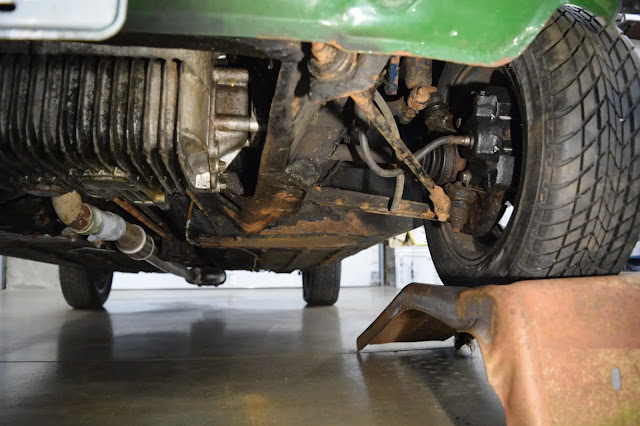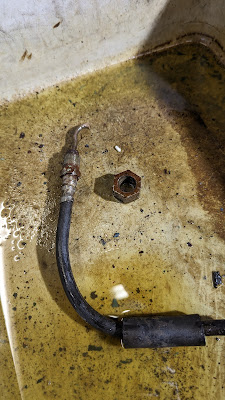 |
| It's a dirty job, but somebody has to do it. |
Time for another update on the Maus project. When we last were here, I was a happy camper. The front subframe, complete with motor, had been extracted from the car, the motor detached and moved to an out of the way location for future attention. First order of business was to turn that dirty, filthy, greasy, smudgey and ugly subframe into a naked subframe. Once that's done I can get an OnlyFans account for it.
I removed the various bits such as stabilizer bars, cones, trumpets, axles and more, until I was left with just the subframe. Hours were spent hammering, wire-wheeling, scraping all the smudge and junk off the frame. Until I ended up with this.
 |
| Shiny, clean subframe - getting a nice degreasing bath |
While this was taking place, all those bits I pulled off were treated to a through inspection. If deemed worthy, it was cleaned up, refreshed and painted, otherwise, replaced.
Audience warning - we're exiting the main narrative and heading down a just noticed path into the dark and scary woods. Don't worry, it's short.
- Digression begins -
I've lived too long in the Porsche/BMW/Subaru universe and this has warped my monetary sense. The old joke goes: You have a Porsche Racecar. What part of Porsche or Racecar means cheap, inexpensive or economical? Porsche parts especially are hugely expensive. Which is why during my racing career I would often purchase what we would call, parts cars. These are vehicles that were involved in an accident; blew the motor or somehow were just done and had to go. Trashed interior, I don't care. Rear end crashed and totaled, but the motor is good. Yes, please. I would buy them from $500 to $1500 and stash them in my back yard. There, they would be immediately be claimed by the huskies as their property.
Get hit in a race and need a new door? Don't get a new one from the dealer - if they would even sell one to you for a 80's car, or even from a junkyard. I'd just stroll out to the backyard and pull it off one of the parts car. Instant savings. Sometimes parts are just No Longer Available (NLA). This is common for vintage vehicles. Often I could pull the part from the parts cars.
When racing, reliability is key. You can't finish first if you don't finish. This means for critical parts like an Air Flow Meter (AFM), a part from that 100K miles Porsche 944 with unknown history just doesn't cut it. Time to go buy new. A new or refurbed water pump will set you back from $150-300. Some parts are thousands of dollars. It's crazy and super expensive with these cars.
I'm working on the motor at the moment, updates in a future post. I needed some new parts. While putting the part in my basket, the website showed me "What others have bought". I had pulled off the water pump, inspected it and other from some internal corrosion, and decided to go with it. The website showed me a brand new upgraded (higher water flow) for $20. Only $20? For a brand new pump? Hell yes! I clicked and added it to my basket.
And even though I'm buying a fair amount of new parts and shipping them from the UK. The pricing is an order of magnitude less than comparable Porsche parts.
 |
| Starting all the way from the bottom |
Once I had a clean and degreased subframe, it was time for some rust protection. I applied 2 coats of Eastwood Rust encapsulating paint as the base.
Starting with the newly painted subframe, it was time to build it back up. That mean going though all the parts that was taken off and doing the clean/inspect/keep or throw away routines. Above is one of the drive axles, cv joint, hub carrier and drive hub. While the hub carrier (middle bit) is okay, it has two ball joints and they gotta go. CV joints need to be inspected and the boots replaced. I replaced the drive hub even though it was good because: 1) it was cheap (see digression above) and 2) the new part was all shiny and you'll see it as soon as you take off the wheel, and I'm all about the bling.
There was a lot of multi-tasking going on. Often I was waiting for a part or two before I can move forward with a section - no next-day air delivery for parts from the UK. I would then move off to another place and work on that. A good example would be the engine compartment. Like the subframe and motor, it was rusty, greasy and looked like you needed a hazmat suit to work on it.
 |
| Speaking of a HazMat suit ... |
Here's an example of the brake and clutch master cylinder area. Note under all the grime, the car was originally painted blue. I also have found red paint on the subframe. The Maus has had an interesting life.
 |
| Pretty scuzzy looking right? |
Suffice to say, lots of bits didn't come easy. I had to resort to my bag of mechanic tricks. Pretty much every fastener was rusty. Most of them will be replaced with new. New ball joints everywhere were installed. On the carrier hub, this was a particular PITA. They need to have a certain amount of pre-load. This is accomplished with shims. The work goes: put in a shim or two. Put the ball in the cup, lock it down and torque it to 75 ft/lbs. Test the drag. Too loose? add another shim. Too tight, remove a shim. That's the theory anyway. The 4 ball joints took over 3 hours to get them "just right".
The ball joint on the control arm on one side defeated me. BFH (Big Fucking Hammer), MAPP gas torch, Sawzall, just nothing worked. It wouldn't come out. That meant the control arms were abandoned and new (camber-adjustable) arms bought.
 |
| Packing the CV joint is a hands-on job |
CV Joints were disassembled and examined. They looked great. I replaced the boots and repacked them.
 |
| Old and new front suspension cones |
The original design of the Mini was pretty unique. They used rubber cones for the suspension. Eventually over time these get compressed and the suspension gets compromized. I bought new ones from the UK. The old ones are in front and you can see they are pretty much used up compared to the new ones.
 |
| finished subframe with lots of new parts - upside down view |
Eventually, probably because I don't have a job to go to anymore, the subframe was finished. It's just waiting to go back into the car. That means I have to finish up the engine compartment refresh - still a work in progress. I'm also working on the motor. The head has been pulled and it's off to the machine shop, where in all likelihood, will sit for several months. Fingers crossed it will be sooner.
And with that, we come to the end of the post. Hopefully if you have read my other posts, you came prepared in case you doze off: All hard objects removed from your area; soft pillow to cushion your head when it crashes into the desk. In any case, the management accepts no responsibility for any injuries occurred.
I'll leave you with a taste of a future installment.









































.jpg)












.jpg)

